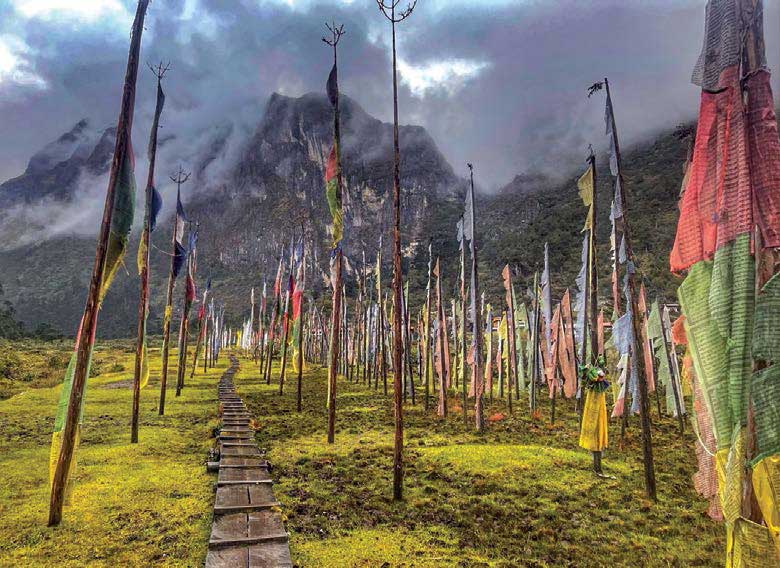A Spiritual sojourn to the lake of mandala Offering Hike
Domendrel Tsho (lake) is located at an elevation of 4,050 meters above sea level above the historical Tango Monastery in the north of Thimphu. Domendrel Tsho is a must-visit for anyone interested in outdoor adventures and exploring the natural beauty of Bhutan! One of popular short day hikes within Thimphu, the hike takes around 5-6 hours for a rgeular hiker. Although the hike is considered to be challenging and ranges from moderate to difficult, this depends on the individual’s fitness level.


The hike starts from the base of Tango Monastery, a highly regarded Buddhist learning center in Bhutan that houses important relics related to the Kagyu tradition. The trail offers breathtaking views of Thimphu city. On clear days, one can also see Gasa Dzong and Punakha Valley. It is also an ideal spot for meditation practitioners due to its peaceful surroundings.
Getting to Domendrel Tsho is quite straightforward if you are based in Thimphu. Drive towards the north until you reach the Tango Monastery parking lot, and follow the well-maintained trail to the left after reaching the monastery. There are signposts along the way to guide you.
Before starting the hike, it is recommended to warm up and stretch. As you climb, you may tire quickly, but the hike is worth it for the stunning views of Thimphu Valley. You will pass by the Dzongkhag Meditation Centre and hike through dense forests to reach the top of the mountain at an elevation of 4,000 meters.
Throughout the hike, you will encounter diverse flora and fauna, as well as prayer flags fluttering in the wind. Make sure to bring enough water and energy bars, as well as a packed lunch, as the hike covers a distance of approximately 10-11 km. Some hikers may experience symptoms of altitude sickness, so it is crucial to be aware of these symptoms and to not take the hike lightly.

Historically, the significance of the lake is not the water itself but the stones piled up in the shape of a mandala offering, called Domendrel Tsho. The stones were consecrated by Gyalse Tenzin Rabgye during a ceremony for his sister’s three-year retreat, known as tshokhor. Legend has it that good fortune and tremendous auspiciousness descended upon his sister when he threw some grains into the air during the ceremony.
There are also two lakes, Lha Tsho of God and Naga, believed to belong to the protector deities Pel Yeshey Goenpo and Tandin. These lakes are also said to be the palace of the protector deity of wakefulness and conscientiousness. The meditation houses of Gyalse Tenzin Rabgye’s parents can be seen around these lakes, as well as a temple on the hilltop above the lake.
The best time to hike to Domendrel Tsho is in autumn, but it is also possible to hike during spring and summer for different experiences with nature. During these seasons, you can enjoy stunning views of mountains and rich flora, including rhododendrons.
The spring and summer months offer a chance to witness the vibrant and lush greenery of the surrounding landscape. For some avid hikers, hiking in the winter months when the mountains are blanketed in snow can also be a unique and breathtaking experience. However, winter hikes can be challenging due to harsh conditions, so it’s important to be prepared.
It’s recommended to visit Domendrel Tsho during the autumn season for the best hiking experience, but it’s also possible to visit during other times of the year for a different perspective on the natural beauty. Whether you’re visiting in autumn, spring, summer or winter, be sure to pay your respects to the sacred environment by offering incense and prayers for peace and prosperity in your life.
Aside from the beautiful surroundings, Domendrel Tsho is also known for its historical significance. It’s not the lake itself that is significant, but rather the piled up stones in the shape of a mandala offering, known as Domendrel Tsho.
According to legend, the mandala offering was consecrated by Gyalse Tenzin Rabgye during a ceremony for his sister’s three-year retreat. When he threw some grains into the air, it is said that good fortune and tremendous auspiciousness descended upon his sister.

Passang Tshering
He is a qualified tour guide (culture and trekking). He leads tour groups across Bhutan. He enjoys photography and Facebook and Instagram blogging. You can follow him on Facebook and Instagram @bhutanwithpassang.


